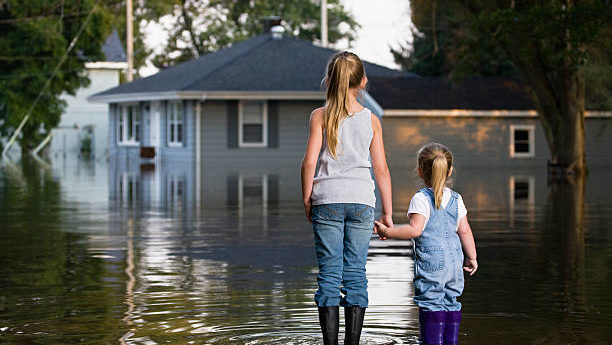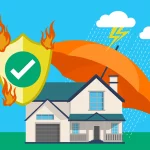Our goal at Credible Operations, Inc., NMLS 1681276, implied as “Substantial,” is to provide you with the tools and assurance you genuinely need to deplete your assets. All evaluations are our own, despite the fact that we sometimes advance items from our companion lenders who pay us for our organizations.
Floods are not covered by the majority of homeowners’ insurance policies. On the off chance that you wish to protect yourself from floods, you should buy a different flood insurance.
While the security provided by contract holders is an important tool for protecting your home and property from disasters and catastrophes, it doesn’t completely protect them. Most common property owners’ insurance policies do not take flooding into account.
Floods can occur everywhere, so getting flood insurance may be a smart move whether or not you reside in a high-risk flood zone. According to FEMA, almost 40% of flood claims received by the National Flood Insurance Program between 2015 and 2019 originated from low- and moderate-flood regions.

You really need to understand all of this information about flood insurance and what it covers.
With Credible, you can without a doubt consider flood insurance rates from auto insurance companies.
What is flood security?
Despite the fact that most house loan holders’ insurance plans do not cover flood damage, floods are still among the most frequently perceived and extreme disastrous events in the eyes of property owners. In addition to your homeowners insurance policy, you should get a separate flood insurance policy to cover your house from flooding-related water damage.
You can either buy this insurance directly from a secret underwriter or through the National Flood Insurance Program (NFIP).
When you have flood insurance, your insurance director will pay to repair or replace your home (after you pay the deductible) and reimburse you the actual monetary value of your damaged personal property. You might be able to choose to insure your own property at a replacement cost that isn’t deductable for decay if you purchase a method from a covert security provider.
What exactly is covered by flood insurance?
Your incorporation could change if you have private flood insurance, depending on the provider. Two types of flood assurance are taken into account by the typical NFIP home flood insurance policy:
Advance Real Estate – This flood insurance coverage covers your house’s actual structure for up to $250,000, including the following: electrical and plumbing systems, stoves, water heaters, home appliances, permanently positioned items like rugs, pantries, and cabinets, blinds, and disposal garbage.
Individual property – This type of NFIP flood insurance covers anything in your house valued up to $100,000, including furniture, clothing, appliances, a microwave, clothes washer, a dryer, curtains, helpful and window climate control frames, carpets, and priceless artwork and fur (up to $2,500).
It is obvious to see that you must obtain both types of incorporation if you want to protect your property and your possessions.
Family INSURANCE: WHAT IT COVERS AND HOW IT WORKS
What blocks flood insurance?
Whether you purchase flood insurance overtly or via the NFIP, your flood insurance policy normally covers damage caused directly by flooding. For instance, you may not have any provision in your game plan for any financial troubles you have as a result of being unable to keep up with your free endeavor.
The flood insurance policy’s typical exclusions also include:
- Housing costs and additional daily expenses before your home are startling
- All of your extra property, such as your decks, yards, wells, swimming pools, and fencing
- Cash, precious metals, or guarantees
- automobiles, ranch trucks, cruisers, and other self-propelled automobiles
Visit Credible to examine several protection offices’ flood insurance estimates.
Does the basement have flood protection?
Basements and buildings are fundamentally not included in flood security. According to the NFIP, a basement is any room with four walls that is underground. An subterranean room or an indented parlor might be thought of as a tornado shelter, as shown by this term.
Cleaning costs, such as siphoning rising water and cleaning from shape and shape, are covered by the Standard Flood Insurance Policy (SFIP). Additionally, SFIP protects specific items associated to your home and individual effects tied to a power source. This plan of action’s components are as follows:
- heaters for the water, stoves, and confined air systems
- tank for fuel
- Heat siphons, water tanks, and frame siphons
- Circuit breakers, connections, switch boxes, and electrical wiring
- Lifts and storage areas
- ladders and associated advancements
- important supporting components
Review that, with the exception of the assumption that they are connected to a power source, individual items in your basement are not typically covered by flood insurance. For instance, your basement’s furniture, clothing, and generators are typically exempt from this rule. To make a more informed decision if you are unclear about the consideration of your technique, talk with your delegate about unusual instances and cutoff criteria.
WHAT IS THE AVERAGE COST OF HOUSEHOLDERS ‘Assurance?
When must you purchase flood insurance?
If you buy a house in a high-risk flood zone and you have a contract that is upheld by an organization, your bank will assume that you need to buy flood insurance in accordance with government regulations. Regardless of whether you reside in a low-risk area, your bank may assume that you need to get a second flood insurance policy to protect the credit.
According to FEMA, areas in high-risk flood zones have a 1% chance of constantly flooding. These areas are known as flood risk localities, and they essentially have a 25% probability of flooding during the course of a typical 30-year contract. FEMA oversees, revives, and makes available to all people Flood Insurance Tariff Cards (COMPANIES). These assistants examine the wager and determine whether flooding is likely to occur in your area.
In order to protect your financial investment in your property, you may need to think about purchasing this insurance, regardless of your lender’s assumptions. One inch of water in your home can damage it for $25,000, according to FEMA.
What does flood insurance typically cost?
A NFIP insurance policy typically costs $ 700, with the exception that if you live in an area with a moderate or low risk of flooding, you may be able to obtain one for less frequently than $ 500.
Additionally, if you use a protection, the amount of your insurance will be based on your wager. Your yearly installments for flood protection may be affected by the following factors:
- Flood plain
- Area, design, and home’s age
- Type of flood cover (building or potentially contents cover)
- aggregate and deductible consideration
Most flood insurance plans are provided by NFIP. To find the local interest protection group near you, visit the National Flood Insurance Program website.



